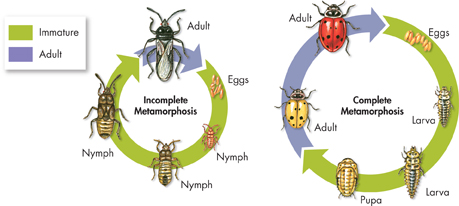How Young Develop Most newborn mammals and newly hatched birds and reptiles look a lot like miniature adults. Infant body proportions are different from those of adults, and newborns have more or less hair, fur, or feathers than adults have. But it is pretty clear that a newly hatched snake is not going to grow up to be something totally different, such as an eagle!
For many other groups of animals, however, it's not as clear. As most invertebrates, nonvertebrate chordates, fishes, and amphibians develop, they undergo metamorphosis. Metamorphosis is a developmental process that leads to dramatic changes in shape and form.
▸ Aquatic Invertebrates Many aquatic invertebrates have a larval stage, which looks nothing like an adult. These larvae often swim or drift in open water before undergoing metamorphosis and assuming their adult form. Members of some phyla, such as cnidarians, have a single larval stage. Other groups, such as crustaceans, may pass through several larval stages before they look like miniature adults.
▸ Terrestrial Invertebrates Insects may undergo one of two types of metamorphosis. Some insects, such as grasshoppers, undergo gradual or incomplete metamorphosis, as shown in Figure 28–19. Immature forms, or nymphs (nimfs), resemble adults, but they lack functional sexual organs and some adult structures such as wings. As they molt several times and grow, nymphs gradually acquire adult structures.
Other insects, such as butterflies, undergo complete metamorphosis. Larvae of these animals look nothing like their parents, and they feed in different ways. Larvae molt and grow, but they change little in appearance. Then they undergo a final molt and change into a pupa (PYOO puh; plural: pupae), the stage in which an insect larva develops into an adult. During the pupal stage, the entire body is remodeled inside and out! The adult that emerges looks like a completely different animal. Don't let your familiarity with caterpillars and butterflies dull your wonder at this change. If land vertebrates underwent this kind of metamorphosis, a larva that looks like a snake could, in fact, grow up into an eagle!

FIGURE 28–19 Insect Metamorphosis Insects usually undergo metamorphosis during their growth and development. The chinch bug (left) undergoes incomplete metamorphosis, in which the nymphs look similar to the adults. The ladybug (right) undergoes complete metamorphosis. The developing larva and the pupa look completely different from the adult.
dTable of Contents
- Formulas and Equations
- Applying Formulas and Equations
- Mean, Median, and Mode
- Estimation
- Using Measurements in Calculations
- Effects of Measurement Errors
- Accuracy
- Precision
- Comparing Accuracy and Precision
- Significant Figures
- Calculating With Significant Figures
- Scientific Notation
- Calculating With Scientific Notation
- Dimensional Analysis
- Applying Dimensional Analysis




